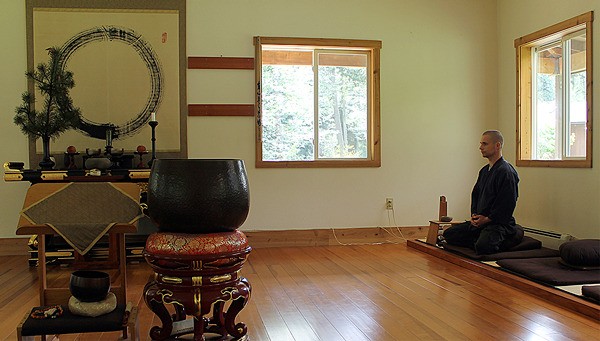According to the tenets of Buddhism, out of death comes life.
Tucked in the woods outside of Freeland lie Tahoma One Drop Zen Monastery and Enso House, a hospice home for the dying.
Several trees punctuate the monastery grounds, memorials for those who have died. Some, such as a fig, plum and cherry, produce fruits for monastery residents and visitors.
They serve as a reminder of the natural process and continuation of life, said Jessica Leon, a member of the Rinzai Zen Buddhist community.
The act of planting trees is also a tradition of the Rinzai school of Zen Buddhism, head monk Kozan added.
Spring Roehm, a Freeland resident, has delivered 19 trees to the monastery in recent years, often acting at the request of mourning family members and friends.
The idea came to Roehm from Judy Rubel, a member of the band SisterMonk Harem, who made the suggestion when Roehm was struggling with the bereavement of a deceased friend.
Each of the head monks, including current head monk Kozan, have planted one or more of the trees.
Most are in memory of community members, including former Freeland resident Dennis Avner a.k.a. Catman, Michael Broderick and Annemarie Bozin.
The late Fred Olson will soon have a tree dedicated to him as well.
Leon’s elderly mother designated a Himalayan birch tree for her own impending death.
She feels safe at the monastery, Leon explained, and enjoys meditating there.
“It’s a good way to prepare,” Leon said.
A fir tree stands in memory of the “sweetest bunny on the fairgrounds,” Rambo, whom Roehm cared for in his final days.
Along the walkway from the garden to the zendo (meditation hall), two trees are planted in honor of Tom Mitsuyu Kelly, a former Clinton resident, and Tim Jundo Williams of Booneville, Mo. Both were longtime students of Shodo Harada Roshi, a Zen master and abbot of the Sogenji monastery in Okayama, Japan.
“I see them as sentries,” Leon said, adding that the two men’s ashes are buried beneath.
“I like to think sometimes, when we’re walking to the zendo between them they are saying ‘do it now, you’re still here, you still have a chance,’ ” Leon said.
Leon, who previously lived at Sogenji monastery, explained that grave sites are commonly places of meditation. At Sogenji, she said, two graveyards located on the monastery property offer visitors a place for meditation and visitation with loved ones.
Buddhist philosophy emphasizes the impermanence of life, both the present life and all of those beyond it.
“It’s an understanding that death is a natural part of life, it’s coming for all of us,” Leon said. “No one is exempt. Embracing that helps life be much richer.”
It’s a way of thinking that is not as common in the United States, she added. More often, death is considered a morbid and depressing topic. 
Kozan explained that zen practice could be considered a death practice.
“You’re supposed to die while you’re still alive, die to your own self,” Kozan said. “Through that death, that is a spiritual death, it is supposed to give you a new sense of life, to re-energize your life.”
The spiritual death, he explained, frees you from bad habits and the “trappings of your own mind.”
“There is a lot of emphasis on death in the way that you are cutting away the past and getting to the root source of your life,” he said.
It is not somber or negative, he emphasized. It is an idea of cleansing, making way for new and positive changes.
Roehm, a friend of Leon and Kozan, regularly stops by the monastery to seek a safe space for meditation and rejuvenation.
Roehm said that things always go well when the monks are in her life.
“Everyday meditation helps me to be a happier person,” she said.
The monastery is one of Whidbey’s hidden secrets, she added, a place of natural beauty and tranquility.
Kozan noted that the monastery is open to any who wish to visit.
He maintains a daily meditation schedule from 5-7 a.m. and 6:30-8:30 p.m.; all are welcome to join. Those who desire a safe place for meditation may stay at the monastery for a few hours or a few days.
Admission is free, though food or other donations are accepted.
Harada Roshi will also be visiting from Japan May 19-26 for a week-long retreat. There is still space available, said Kozan, for any who would like to participate.
“It’s a great gift to have people come and take part in the practice,” Kozan said. “If you’re serious about wanting to do it, there is a space available for that on the island.”


